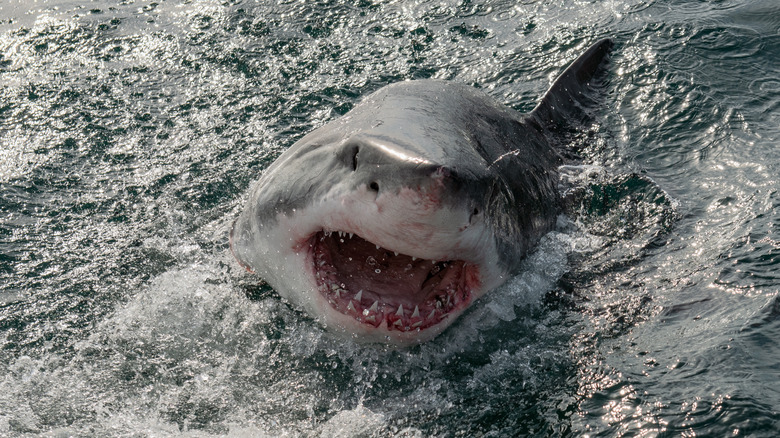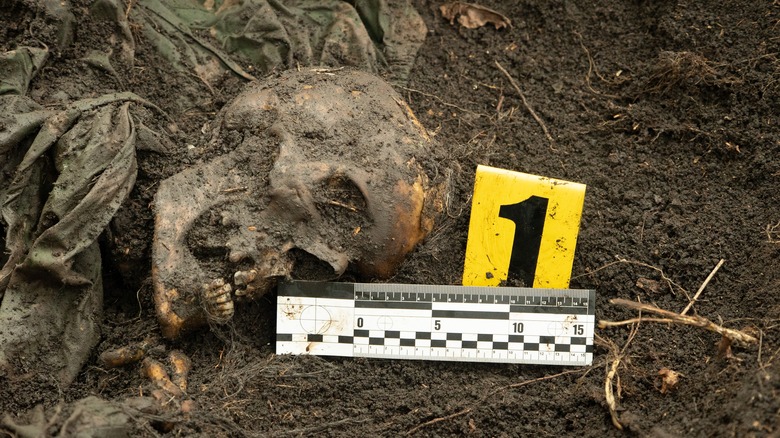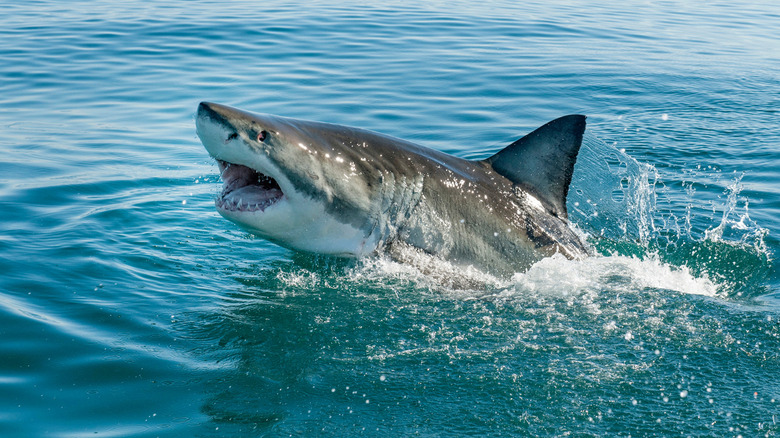Gruesome Details Found In 3,000-Year-Old Shark Attack Victim's Skeleton
Ancient burial grounds are an excellent place to unearth the sordid secrets of humanity. Take, for example, Japan's Tsukumo burial site, which was first excavated more than a century ago in 1915, according to Ars Technica. Hidden deep within the region of Okayama Prefecture lie approximately 170 human skeletons dating back to the Late-Final Jōmon period, an ancient era often associated with Japanese pottery, but that is, in this case, also marked by bloodshed (via Britannica).
The Tsukumo cemetery was once the subject of a study on prehistoric violence in Japan. Previous excavations of this site yielded several fascinating finds including deer antler earrings, shell bracelets, stone implements, and various types of primitive pottery (via Kyoto Imperial University). Other excavated discoveries were more macabre, like the baby skeleton inside a cinerary urn.
But it wasn't until 2016, when the University of Oxford researchers J. Alyssa White and Rick Schulting took a closer look at the male skeleton known as Tsukumo No. 24, that evidence of extremely violent conflict was uncovered (per CBC Radio). Much to the researchers' surprise, the violent conflict that took a fatal turn was not human vs. human, but human vs. shark. The gruesome details found in the report reveal the horrors of the oldest shark attack in human history.
Tsukumo No. 24 was killed by a shark about 3,000 years ago
According to CBC Radio, what started as a study about human conflict in prehistoric Japan, quickly transformed into a murky murder mystery centered on one violent victim's remains. It was clear that Tsukumo No. 24 had been killed in a most gruesome way. The question was ... by whom?
First, White and co-author Schulting considered the possibility that No. 24 was killed by a fellow human being. For that to be true, the wounds sustained had to be caused by metal weapons, which was impossible. Metal weapons capable of this type of violence had not been invented at the time of the attack. Carnivorous land beasts like bears were ruled out as well. The search continued stretching from land to sea.
According to a report from the Kyoto Imperial University, Japan's Tsukumo burial site was discovered half a mile from the sea but was likely right next to the coast 3,000 years ago. Combine this information with the fact that the wounds sustained were comparable to a 1,000-plus-year-old shark attack that took place off the coast of Puerto Rico (via the Florida Museum) and voila — the culprit emerges from the depths of the deep, rippling blue waters.
The mutilated skeleton had 790 injuries
As it turns out Tsukumo No. 24 was killed by a shark 3,000 years ago, making this the earliest shark attack on public record, according to the paper published in The Journal of Archeological Science. But it wasn't just the antiquity that made the matter so remarkable. It was also the markings left behind. Archeologists estimate that the victim sustained a jaw-dropping 790 injuries as the carnivorous sea creature whaled on him relentlessly.
Smithsonian Magazine reports that the skeleton was covered in tooth marks, fractures, incisions, and puncture wounds that did not heal. The violent encounter ended in death. Forensic evidence suggests the victim succumbed to leg, arm, chest, and stomach injuries.
Making use of modern x-ray computed tomography, technicians from the Florida Program for Shark Research made a map of all the gruesome wounds. Fractured ribs, an eviscerated abdomen, and a severed left hand were among the most notable injuries, leading scientists to suspect the attacker was either a tiger shark or the notorious great white shark. Still, one mystery remains ... How did the body get back to the burial ground with such ghastly injuries sustained?
Tsukumo No. 24 was probably fishing with friends
In a candid interview with CBC Radio, the chief researcher of this study, Ph.D. candidate J. Alyssa White, expressed a great deal of sympathy for the victim, whose name is but a number in an ancient grave. While his death was among the most gruesome acts of violence ever seen, even in terms of shark attacks, his burial suggests that his life was the opposite.
Smithsonian Magazine reports that based on forensic analysis, the man who was attacked was probably fishing with friends when the incident occurred. His body was not left in the water for long. It was pulled out almost immediately after the attack. The unnamed victim was buried with care, in a crouched position, suggesting he was a well-regarded community member.
This careful burial left a well-preserved skeleton ripe for scientific analysis. There is some irony in the fact that a study centered on prehistoric human violence revealed this kind of communal compassion even in the face of imminent danger.
Shark attacks are rare events for humans
Ancient shark attack victim remains are unimaginably rare finds for archeologists for many reasons (via CBC Radio). One of the most important reasons is that shark attacks on humans seldom happen. This case stands out as an exception to the general rule.
According to the National Ocean Service, of the 300 or so shark species navigating the ocean waters, only about a dozen of them pose any serious threat to humans. In fact, the odds of dying from a fatal shark bite are currently 1 in 3.7 million (per the LA Times).
White described the unique circumstances surrounding this discovery with the following statement, "The chances of someone being in a shark attack, one this severe, and then to have been buried in a shell mound that protected his bones from the relatively acidic soil in Japan that usually erodes organic material quite quickly, and then for us to find him and be able to investigate his remains, it's quite remarkable."




